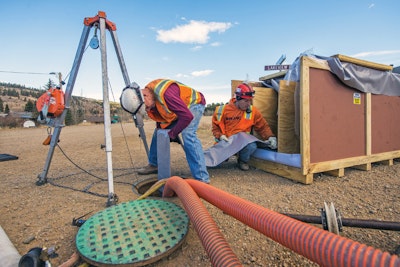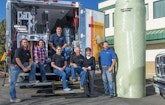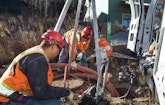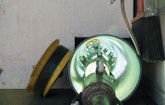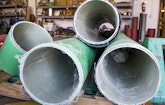
Interested in Relining/Rehab?
Get Relining/Rehab articles, news and videos right in your inbox! Sign up now.
Relining/Rehab + Get AlertsEmbracing new, relatively unknown technology is a high-risk, high-reward proposition for many contractors. Using that technology to bid on a job that’s exponentially bigger than anything a contractor has ever attempted before ups the ante even more.
That was the situation Larry and Chrystalla Larson faced in 2009, and as they learned, nothing ventured truly means nothing gained. By taking a large but calculated risk, the owners of C&L Water Solutions in Littleton, Colorado, parlayed an investment in UV-cured fiberglass pipe lining technology into a game-changing bid on a huge project that drastically altered the then-struggling company’s fortunes.
The project centered on lining roughly 20,000 feet of sewer mains and service lines at the Denver Federal Center, a sprawling facility close to downtown Denver. The company’s bid was $1.4 million — quite a step for a company that had never submitted a bid worth more than $100,000, says Chris Larson, the couple’s son and vice president of operations.
“My parents felt we were biting off more than we could chew,” Larson recalls. “But I felt very strongly that we had to bid on it. We were spinning our tires at the time and close to bankruptcy after taking out $1 million in loans to invest in equipment. There was a lot on the line.”
Larson was confident the company could handle the job because of its array of services, which at the time included lining, excavating and pipe bursting. “We could do everything required within the scope of the contract, and they preferred to work with one contractor instead of four or five,” he explains. “So we won the contract on the basis of our flexibility and having all that technology in our back pocket.
“It eventually turned into about a $2.3 million contract,” he says of the two-year-long project. “We made way more money in that two years than we’d made in many more years before combined. And all that additional revenue bought us time to grow the marketplace (for UV-cured fiberglass lining). It was a game-changer.”
Starting out small
Bidding on such a large project wasn’t even on the Larsons’ radar when they founded C&L Backhoe Excavating in 1979. The couple started out with just a Ford rubber-tire backhoe, using their basement as an office and their garage for a warehouse. In 1985, they moved the business to a 3,000-square-foot building. And in 2000, they moved into a newly built 19,000-square-foot building, a reflection of the company’s steady growth.
A focus on a market niche — performing small sewer and water repairs for local municipalities — spurred the company’s growth. By the mid-2000s, the Larsons had built up a customer base that included 40-some municipalities in the Denver metropolitan area.
“They literally got in on the ground floor,” says Larson, who helped his parents at work while growing up and joined the company in 2007 after graduating from the University of Denver with a degree in real estate and construction management. His brother, Jason, vice president of technology, came on board in 2009. “No one else was doing that kind of work,” he recalls. “Everyone else was focused on the construction boom. … At the time, a lot of the surrounding Denver area was being developed.”
A request from a longtime customer in 2006 jump-started the company’s move toward service diversification. The municipality urged the Larsons to offer trenchless pipe rehabilitation, because its engineers felt it was a superior method for sewer and waterline repairs. After much research, Larry Larson determined that a fiberglass CIPP liner made by Saertex GmbH Co., combined with UV-curing technology from ProKASRO Mechatronik GmbH, was the best technological route to take.
“My dad wanted to do something no one else was doing: differentiating himself in the marketplace,” Larson says. “And very few companies in the U.S. were lining sewer mains this way. In fact, we were one of the first ProKASRO customers in the United States.”
Why opt for a UV-curing technology and fiberglass liners? For starters, a fiberglass liner is thinner than the more commonly used felt liner. As such, it maximizes pipes’ total hydraulic capacity. In addition, the lining can be inspected before it cures because the so-called “light train” curing system (picture a chain of small, wheeled carriers outfitted with UV lights) includes an inspection camera that enables installers to spot flaws before they’re too difficult and costly to eliminate.
“With a felt liner, you don’t know what you have until you inspect it after it’s cured,” Larson explains. “There’s more leeway with UV-curing technology. On one job, for example, the inspection camera showed a small Hot Wheels truck under the liner that a kid must’ve flushed down a toilet, after we started lining the pipe. But we were able to deflate the liner and remove it before finishing the job.”
Unexpected obstacle
But the company’s plan hit a snag: Using felt liners for pipe lining was dramatically cheaper than UV methods. And since most public works projects use a low-bid procurement process, fiberglass lining was a tough sell, Larson says.
But it wasn’t impossible. Convincing municipalities to consider using a more expensive pipe lining method required doing a lot of demonstrations, or “lunch-and-learns,” as Larson calls them. “It was a foreign concept to a lot of people, so we had to prove the technology was viable and get engineers to understand the advantages so they would write it into their bid parameters,” he says.
Landing the Denver Federal Center job was instrumental to the company’s success. For starters, the company’s revenue has more than quintupled since then, from roughly $3 million to $15 million in gross revenue. Over the years, that influx of cash enabled the company to invest in additional equipment, which it used to enter new markets. Furthermore, it allowed the Larsons to figure out a more profitable pricing structure.
“We didn’t have any historical data to help us out there,” Larson points out. “But eventually we started drumming up business with other municipalities and built up some momentum. If not for that big job, I don’t know where we’d be today.”
Aided by the revenue boost, the company branched out into other service offerings, including grouting, lateral lining (using an LMK Technologies felt-lining system), manhole rehabilitation, pipe bursting and sliplining. “That’s been our market niche — projects where municipalities prefer to use one contractor that can do everything,” Larson says.
“We bid on projects that need two or three of our services and when we do that, it’s hard to compete against us.”
The company also carved out a niche for taking high-risk, high-reward jobs that most contractors don’t want to handle. As an example, Larson cites one job that involved relining a culvert located under a highway. The only problem: One end of the culvert jutted out of a steep slope. That required workers to rappel about 30 feet down the side of the cliff and improvise a bit to get the liner through the culvert.
“We’re not a very big company, but we get paid well because we know how to do high-risk projects,” he notes. “Plus, we’re vertically integrated, which allows us to be more price competitive. We have our hand in a lot of technology jars, which is the main reason we rebranded the company by naming it C&L Water Solutions.”
Equipment matters
The company’s services eventually fit into three distinct divisions: service and repair work, which includes leak detection and pipeline inspections; excavations for pipeline repairs; and trenchless pipeline rehabilitation. And as services expanded, so did the company’s fleet of equipment.
On the company’s service side, equipment includes two sound leak detection devices (leak correlators) made by SubSurface Locators, two SuperFreeze pipe-freezing systems made by RIDGID, one RIDGID SeeSnake inspection camera, a line locator made by Radiodetection, holiday detectors made by Tinker & Rasor, and an adhesion tester made by Defelsko Posi-Tester (for testing how well lining systems adhere to their substrate).
In the pipe lining end of the business, the company relies on four CCTV trucks equipped with camera systems built by Aries Industries; four winches made by TT Technologies; an Aries grout truck for lateral and mainline grouting; two LMK lateral pipelining systems; four lateral reinstatement systems made by ProKASRO and Schwalm Robotic; two US Jetting 4018 trailer jetters (4,000 psi at 18 gpm); one Mongoose trailer jetter made by Sewer Equipment (4,000 psi at 18 gpm); three ProKASRO-equipped UV-curing trucks; six 8-inch Godwin, a Xylem brand pumps, used primarily for sewer bypass work; two pipe bursting systems built by TT Technologies; air compressors made by Ingersoll Rand; and two Clemco Industries sand-blasting pods.
For excavating, the company owns five mini-excavators and track excavators made by Link-Belt (a brand owned by LBX Co.) Caterpillar and Volvo; five rubber-tire Caterpillar backhoes; three Bobcat skid-steers; two Volvo front-end loaders; five Mack, Kenworth and Peterbilt dump trucks with dump bodies made by Ox Bodies Inc.; two forklifts made by Caterpillar and Kalmar; six Load King flatbed and low-boy trailers; and two SpoilVac trailer-mounted vac units made by VACMASTERS.
Looking ahead, a succession plan calls for Larson and his brother to become majority owners of the company in about a year or so, with their parents still maintaining an ownership stake. Larson says he’s both excited and nervous about the change, and that he and Jason are looking forward to slower, more controlled growth after the exponential growth of the last seven years.
“Consistency is the name of the game,” he says. “We were fortunate enough to achieve explosive growth. It came along totally unplanned — a textbook case of opportunity meeting preparation. But if we grow slower now and can better control it, I’m OK with that.”
Does Larson feel pressure to maintain the family’s business legacy? Not really, he says. “We have a long-term plan in place. A key driver for us is maintaining our core values: Providing high-quality service and putting our people and customers first. We don’t need 15 core values or principles. We just focus on our people — keeping them safe — while at the same time keeping our clients happy and providing the highest-quality work possible.”
It isn’t personal, it’s business
The Larson family — parents Larry and Chrystalla and sons Chris and Jason — used to openly debate and dispute ideas and strategies proposed during monthly managers’ meetings at C&L Water Solutions in Littleton, Colorado. And in the heat of battle, things often got a little, well, personal.
“The biggest problem that arises while working with family members is that there’s no line between business and family,” says Chris Larson, who in a year or so will join Jason in running the company their parents founded in 1979. “For whatever reasons, it’s easier to forget there should be respect and mutual appreciation.
“I sometimes find myself disagreeing with my brother before the third word about an idea or proposal comes out of his mouth,” Chris adds wryly. “It’s so much easier to disagree with family members faster than you would with, say, an employee.” In short, Chris says it’s a challenge to keep business impersonal, set aside sibling rivalries, and deal with disputes that arise when old and new ideas clash.
To avoid damaging public conflicts, the Larsons developed a simple but strategic work-around: Meet once a month in a setting outside the company and hash things out ahead of time, before the monthly staff meetings. So, instead of settling things out in the open, they try to work through issues among themselves first, as systematically and dispassionately as possible.
“We do things like go through next month’s goals and work schedule, and talk about purchasing decisions,” he explains. “That way, everyone is on the same page when the managers’ meeting comes around.”
A lot of the disagreements stem from the fact that Larry and Chrystalla are more conservative than Chris and Jason when it comes to business issues such as growth, equipment purchases and job bids. While the parents are fairly comfortable with the way the business runs now, the sons want to invest in new software and equipment that will drive increased productivity and steer the company toward new markets, for example.
“They get really nervous when they see their 37-year investment in this business handled aggressively,” he notes. “That’s where we usually butt heads.”
But as time goes on, Chris says he actually finds that it’s easier to see his parents’ point of view. “I guess that as my brother and I get more mature — maybe even more like our parents — and as we handle more of the business itself and see what it really means to go into debt for $100,000 to buy a new piece of equipment, it gives us a greater appreciation for their side of things.”
What’s the best advice Chris can give other families that work together? Never take each other for granted. Always treat each other with respect. Don’t handle differences in front of other employees. And when things get heated, take a break and talk later when cooler heads can prevail.
“There’s nothing wrong with disagreeing,” he points out. “We encourage debate. People are passionate about their opinions and we want that. But families are more prone to attack each other personally because we know how to press each others’ buttons. So it’s important to remain respectful.”
